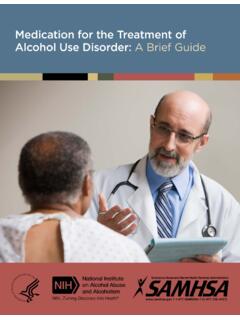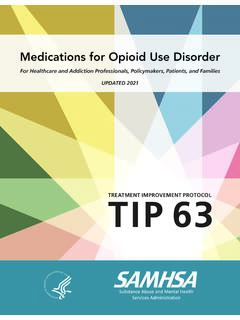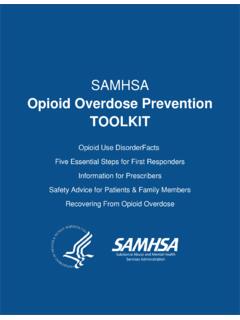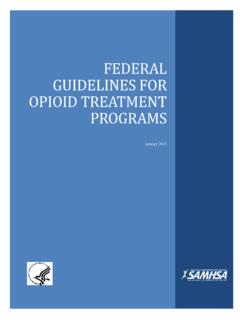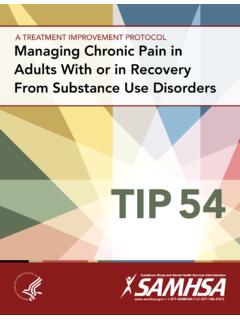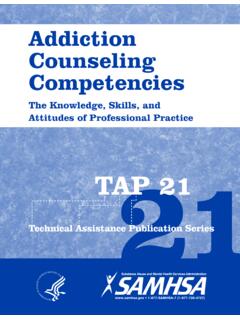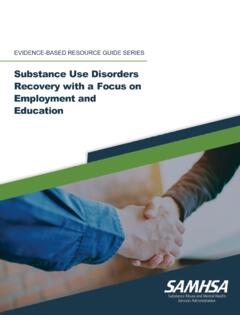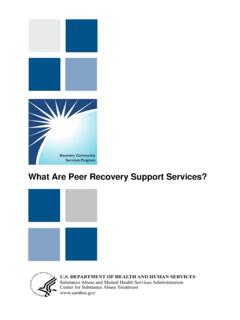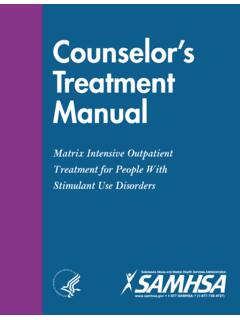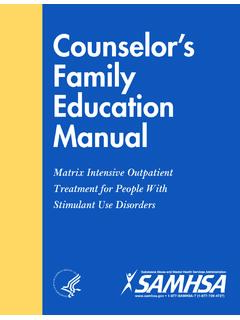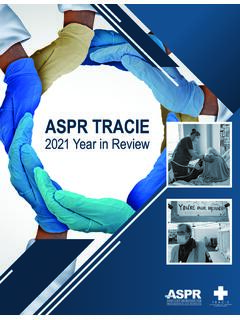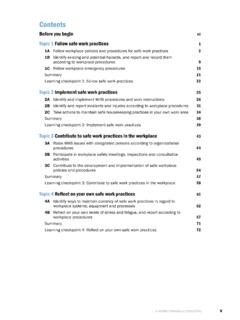Transcription of National Strategy for Suicide Prevention Implementation ...
1 National Strategy for Suicide Prevention Implementation Assessment Report 2 [This page intentionally left blank] 3 National Strategy for Suicide Prevention Implementation Assessment Report Department of Health and Human Services Substance Abuse and Mental Health Services Administration 4 Acknowledgments This report regarding the work of the National Action Alliance for Suicide Prevention s NSSP Implementation Assessment Advisory Group was prepared by the Substance Abuse and Mental Health Services Administration (SAMHSA), Department of Health and Human Services. Chelsea L. Booth, , served as the primary SAMHSA contact on the project. Disclaimer The views, opinions, and content of this publication are those of the author and do not necessarily reflect the views, opinions, or policies of SAMHSA or HHS.
2 Nothing in this document constitutes a direct or indirect endorsement by SAMHSA or HHS of any non-federal entity s products, services, or policies, and any reference to non-federal entity s products, services, or policies should not be construed as such. Public Domain Notice All material appearing in this publication is in the public domain and may be reproduced or copied without permission from SAMHSA. Citation of the source is appreciated. However, this publication may not be reproduced or distributed for a fee without the specific, written authorization of the Office of Communications, SAMHSA, HHS. Electronic Access This publication may be downloaded at 5051.
3 Recommended Citation Substance Abuse and Mental Health Services Administration: National Strategy for Suicide Prevention Implementation Assessment Report. HHS Publication No. SMA17 5051. Rockville, MD: Center for Mental Health Services, Substance Abuse and Mental Health Services Administration, 2017. Originating Office Suicide Prevention Branch, Center for Mental Health Services, Substance Abuse and Mental Health Services Administration, 5600 Fishers Lane, Rockville, MD 20857, HHS Publication No. SMA17 5051. Printed 2017. Nondiscrimination Notice SAMHSA complies with applicable Federal civil rights laws and does not discriminate on the basis of race, color, National origin, age, disability, or sex.
4 SAMHSA cumple con las leyes federales de derechos civiles aplicables y no discrimina por motivos de raza, color, nacionalidad, edad, discapacidad o TABLE OF CONTENTS TABLE OF CONTENTS .. 5 PREFACE .. 7 EXECUTIVE SUMMARY .. 8 METHODOLOGY .. 11 National Strategy FOR Suicide Prevention GOAL- BY- GOAL Implementation SUMMARY .. 13 Goal 1 Integrate and coordinate Suicide Prevention activities across multiple sectors and settings .. 13 Goal 2 Implement research-informed communication efforts designed to prevent Suicide by changing knowledge, attitudes, and behaviors .. 16 Goal 3 Increase knowledge of the factors that offer protection from suicidal behaviors and that promote wellness and recovery.
5 18 Goal 4 Promote responsible media reporting of Suicide , accurate portrayals of Suicide and mental illnesses in the entertainment industry, and the safety of online content related to Suicide .. 20 Goal 5 Develop, implement, and monitor effective programs that promote wellness and prevent Suicide and related behaviors .. 21 Goal 6 Promote efforts to reduce access to lethal means of Suicide among individuals with identified Suicide risk .. 23 Goal 7 Provide training to community and clinical service providers on the Prevention of Suicide and related behaviors .. 25 Goal 8 Promote Suicide Prevention as a core component of health care services.
6 27 Goal 9 Promote and implement effective clinical and professional practices for assessing and treating those identified as being at risk for suicidal 28 Goal 10 Provide care and support to individuals affected by Suicide deaths and attempts to promote healing and implement community strategies to help prevent further suicides .. 296 Goal 11 Increase the timeliness and usefulness of National surveillance systems relevant to Suicide Prevention and improve the ability to collect, analyze, and use this information for action .. 30 Goal 12 Promote and support research on Suicide 32 Goal 13 Evaluate the impact and effectiveness of Suicide Prevention interventions and systems and synthesize and disseminate 33 Summary of Recommendations.
7 35 State, tribal, and community-level Suicide Prevention infrastructure .. 35 Blueprint for community action .. 36 Comprehensive state and community Suicide Prevention efforts .. 38 Conclusion .. 40 APPENDIX A BIBLIOGRAPHY .. 41 APPENDIX B CONTRIBUTORS .. 457 PREFACE Suicide in the United States is continuing to increase. Over 44,000 Americans died by Suicide in 2015 , and both the rate of Suicide and the numbers of Americans who have died by Suicide has increased annually over the last decade. Overall, Suicide rates in creased 28 percent from 2000 to 2015 (CDC, WISQARS). In addition, presentations to emergency Departments because of suicidal ideation have been increasing at a rate of 12 percent annually (Owens et al.)
8 , 2017). This has occurred despite the 2012 publication of a revised National Strategy for Suicide Prevention , despite a steady increase in knowledge about Suicide Prevention , and despite unprecedented levels of Suicide Prevention activity. This report concludes that despite this increasing level of activity, efforts to implement all that we know about Suicide Prevention as part of a comprehensive approach that seeks to prevent Suicide across the lifespan (including adults as well as youth) have been rare. The report attempts to provide a snapshot of recent efforts to implement the goals and objectives of the National Strategy for Suicide Prevention and makes suggestions for increasing the effectiveness of these Implementation efforts.
9 8 EXECUTIVE SUMMARY The magnitude of efforts to reduce Suicide in America and our growing knowledge about what is effective in reducing Suicide while still incomplete are also greater than ever before. It was this fact that led the United States Surgeon General, in collaboration with the National Action Alliance for Suicide Prevention (Action Alliance, ), to revise the original National Strategy for Suicide Prevention ( National Strategy ) in 2012. The Action Alliance is the public-private partnership charged with advancing National Strategy goals that require National collaboration and leverage. It was launched by the Secretaries of the Department of Health and Human Services (HHS) and the Department of Defense (DoD) in 2010.
10 In 2014, the Action Alliance created the National Strategy for Suicide Prevention Implementation Assessment Advisory Group (NSSP IAAG) to better understand how the country was implementing the 2012 National Strategy , challenges to Implementation , and recommendations for overcoming those challenges. The goal of the National Strategy for Suicide Prevention Implementation Assessment Report ( National Strategy Implementation Report) is to inform National stakeholders and policymakers as they work to enhance and refine efforts to advance the National Strategy and to save lives in this country. The NSSP IAAG gathered information by: Surveying major National Suicide Prevention organizations, including members of the National Council for Suicide Prevention ( ); Reviewing transcripts of the Substance Abuse and Mental Health Services Administration s (SAMHSA) Regional Directors targeted discussions with state Suicide Prevention leads ( ); Reviewing the work of three agencies (HHS, DoD, and the Department of Veterans Affairs) that are members of the Federal Working Group on Suicide Prevention ( ), which mapped their Suicide Prevention activities onto the National Strategy goals.
